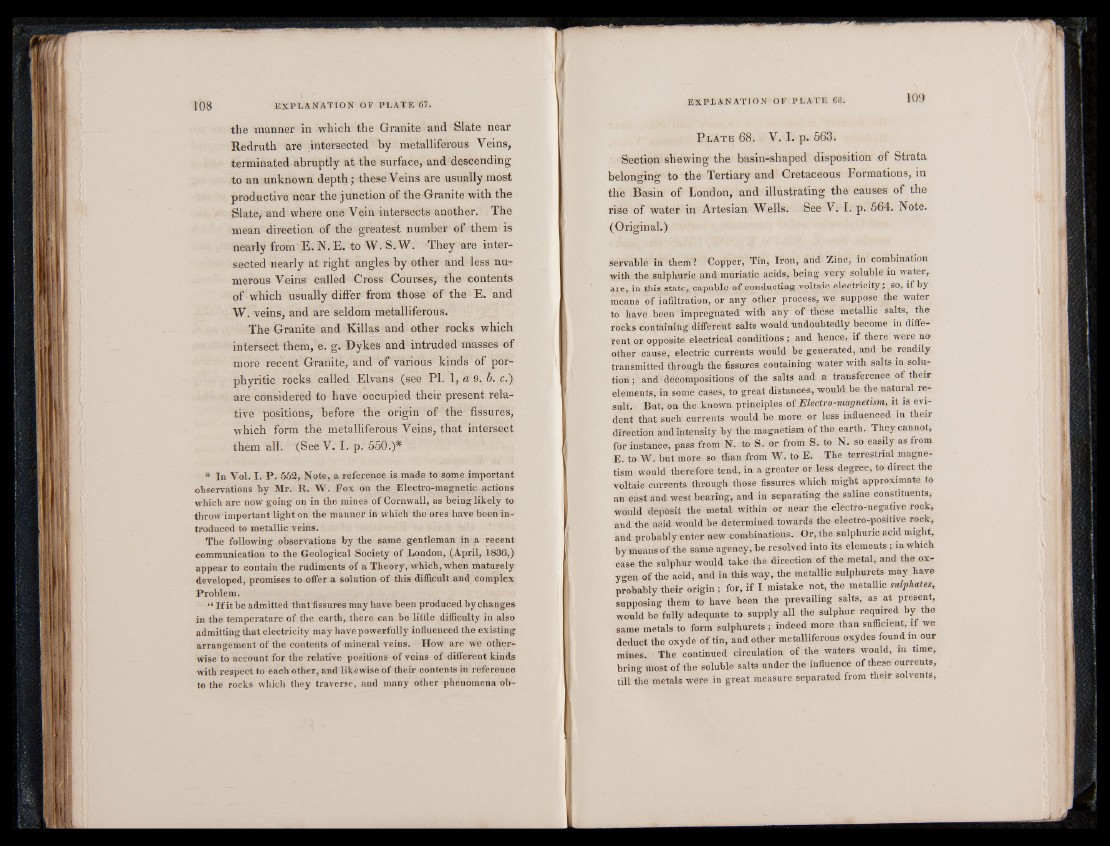
the manner in which the Granite and Slate near
Redruth are intersected by metalliferous Veins,
terminated abruptly at the surface, and descending
to an unknown depth; these Veins are usually most
productive near the junction of the Granite with the
Slate, and where one Vein intersects another. The
mean direction of the greatest number of them is
nearly from E. N. E. to W. S. W. They are intersected
nearly at right angles by other and less numerous
Veins called Cross Courses, the contents
of which usually differ from those of the E. and
W. veins, and are seldom metalliferous.
The Granite and Killas and other rocks which
intersect them, e. g. Dykes and intruded masses of
more recent Granite, and of various kinds of por-
phyritic rocks called Elvans (see PI. 1, a 9. b. c.)
are considered to have occupied their present relative
positions, before the origin of the fissures,
which form the metalliferous Veins, that intersect
them all. (See V. I. p. 550.)# *
* In Vol. I. P . 552, Note, a reference is made to some important
observations by Mr. R. W. Fox on tbe Electro-magnetic actions
which are now going on in the mines of Cornwall, as being likely to
throw important light on the manner in which the ores have been introduced
to metallic veins.
The following observations by the same gentleman in a recent
communication to the Geological Society of London, (April, 1836,)
appear to contain the rudiments of a Theory, which, when maturely
developed, promises to offer a solution of this difficult and complex
Problem.
“ If it be admitted that fissures may have been produced by changes
in the temperature of the earth, there can be little difficulty in also
admitting that electricity may have powerfully influenced the existing
arrangement of the contents of mineral veins. How are we otherwise
to account for the relative positions of veins of different kinds
with respect to each other, and likewise of their contents in reference
to the rocks which they traverse, and many other phenomena ob-
P l a t e 68. V. I . p. 663.
Section shewing the basin-shaped disposition of Strata
belonging to the Tertiary and Cretaceous Formations, in
the Basin of London, and illustrating the causes of the
rise of water in Artesian Wells. See V. I. p. 564. Note.
(Original.)
servable in them? Copper, Tin, Iron, and Zinc, in combination
with the sulphuric and muriatic acids, being very soluble in water,
are, in this state, capable of conducting voltaic electricity; so, if by
means of infiltration, or any other process, we suppose the water
to have been impregnated with any of these metallic salts, the
rocks containing different salts would undoubtedly become in different
or opposite electrical conditions ; and hence, if there were no
other cause, electric currents would be generated, and be readily
transmitted through the fissures containing water with salts in solution
; and decompositions of the salts and a transference of their
elements, in some cases, to great distances, would be the natural result.
But, on the known principles of Electro-magnetism, it is evident
that such currents would be more or less influenced in their
direction and intensity by the magnetism of the earth. They cannot,
for instance, pass from N. to S. or from S. to N. so easily as from
E. to W. but more so than from W. to E. The terrestrial magnetism
would therefore tend, in a greater or less degree, to direct the
voltaic currents through those fissures which might approximate to
an east and west bearing, and in separating the saline constituents,
would deposit the metal within or near the electro-negative rock,
and the acid would be determined towards the electro-positive rock,
and probably enter new combinations. Or, the sulphuric acid might,
by means of the same agency, be resolved into its elements ; in which
case the sulphur would take the direction of the metal, and the oxygen
of the acid, and in this way, the metallic sulphurets may have
probably their origin ; for, if I mistake not, the metallic sulphates,
supposing them to have been the prevailing salts, as at present,
would be fully adequate to supply all the sulphur required by the
same metals to form sulphurets ; indeed more than suflicient, if we
deduct the oxyde of tin, and other metalliferous oxydes found in our
mines. The continued circulation of the waters would, in time,
bring most of the soluble salts under the influence of these currents,
till the metals were in great measure separated from their solvents,